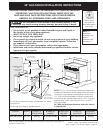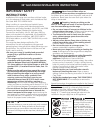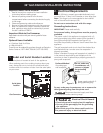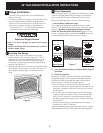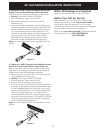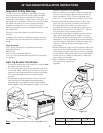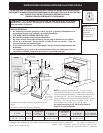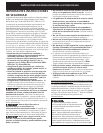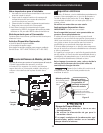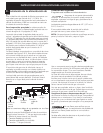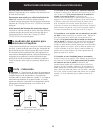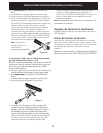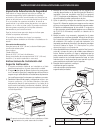
5
36" GAS RANGE INSTALLATION INSTRUCTIONS
Do not use a flame to check for leaks
from gas connections. Checking for leaks with a flame
may result in a fire or explosion.
All openings in the wall or floor where the range is to be
installed must be sealed.
Tighten all connections if necessary to prevent gas
leakage in the cooktop or supply line.
Disconnect this range and its individual shutoff
valve from the gas supply piping system during any
pressure testing of the system at test pressures greater
than 1/2 psig (3.5 kPa or 14"(35,56 cm) water column).
Isolate the range from the gas supply piping system
by closing its individual manual shutoff valve during any
pressure testing of the gas supply piping system at test
pressures equal to or less than 1/2 psig (3.5 kPa or
14"(35,56 cm) water column).
4. Moving the Appliance for
Servicing and Cleaning
Turn off the range line fuse or circuit breakers at the main
power source, and turn off the manual gas shut-off valve.
Make sure the range is cold. Open the oven door. Lift the
range at the front and slide it out of the cut-out opening
without creating undue strain on the flexible gas conduit.
Make sure not to pinch the flexible gas conduit at the back
of the range when replacing the unit into the cut-out
opening. Close the door and switch on the electrical power
and gas to the range.
5. Range Placement
To eliminate the risk of burns or fire from
reaching over heated surface units, cabinet storage
space located above the range should be avoided. If
cabinet storage space is to be provided, the risk can be
reduced by installing a range hood that projects
horizontally a minimum of 5" (12.7 cm) beyond the
bottom of the cabinet.
Figure 5
Follow instructions for
the type of installation you have
Center
Line of
Range
If range will be installed with a cabinet on both
sides, draw a center line on the floor between the
cabinets (see figure 5). If back of range will not be
flush with the wall (the location of the outlet may not
allow the range to be positioned against the wall), draw
a line on the floor where the back edge of the range will
be. Now install anti-tip bracket (see "Anti-Tip Bracket
Installation", page 8).
If range will be installed with a cabinet on one side
only, move the range into final position. Draw a line on
the floor along the side of the range that is not against
the cabinet. If back of range will not be flush with
the wall (the location of the outlet may not allow the
range to be positioned against the wall), draw a line on
the floor where the back edge of the range will be. Now
install anti-tip bracket (see "Anti-Tip Bracket
Installation", page 8).
If range will not be installed against a cabinet,
move range into final position. Draw a line on the floor
along both sides of the range. If back of range will not
be flush with the wall (the location of the outlet may
not allow the range to be positioned against the wall),
draw a line on the floor where the back edge of the
range will be. Now install anti-tip bracket (see "Anti-Tip
Bracket Installation", page 8).



